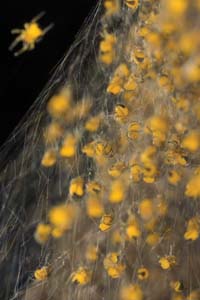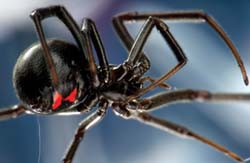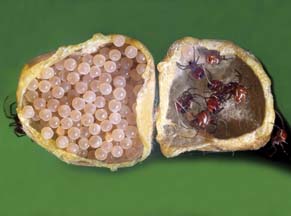 |
 |
| current issue |  |
past issues |  |
send a letter/news |  |
address update |  |
advertise |  |
about us |  |
alumni home |
Features
Spider ManPage 2 of 4
 Ingo Arndt/Getty Images
Ingo Arndt/Getty ImagesAND BABY MAKES 300: Garden spiderlings after hatching. |
The Education of a Spider Man
When Tillinghast was 16, he and Howie returned to live with their mother, who convinced Howie to quit school and get a job and urged Ed to do the same. He resisted out of sheer obstinacy. "For all intents and purposes, I wasn't going to school," he says. "I was only sitting there." A year later he was invited to move in with a minister and his family. For reasons Tillinghast still can't explain, he experienced a kind of intellectual awakening and began reading every book he could lay his hands on.
Despite a weak high school record, Tillinghast was accepted at the University of Rhode Island with, he suspects, the minister's help behind the scenes. There, he took a shine to zoology and, in particular, earthworms. He eventually earned a doctorate in physiology at Duke. After joining the UNH faculty in 1967, he gravitated to his true calling—the study of the physiology of spiders. Before long he found himself in another intellectual renaissance. This time, it took the form of an explosion of ideas, questions to ask and puzzles to solve. One day in a cell biology lab, he was demonstrating how to test for proteins, fats and carbohydrates. Spider silk was believed to be made of pure protein at the time, but in a flash of insight, he wound a spider's web onto a glass rod and asked a graduate student, Edward Kavanagh '79G, to dip it into a chemical that tests for carbohydrates. When the web turned pinky red, the pair had discovered—in front of a class—that spider silk also contains carbohydrates.
The change in research interests also had a big impact on Tillinghast's soft-spoken wife, Margaret, who turned out to be an unflappable spider-hunting companion. "Fortunately, I'm not afraid of the things," she says, recalling the day when she found a tiny spider crawling up her leg on the way back from a Southern spider-collecting expedition. Soon there was another one crawling up her leg. And another and another. The couple pulled over and retrieved a plastic capsule holding a black widow's egg sac. The spiderlings had hatched unexpectedly and were emerging through the air hole in the container.
Nightmare Weaver
It is Tillinghast who gets a call—and gets to keep the spider—whenever a black widow has been found in the state of New Hampshire. All the black widows he's received so far have been of the Southern or Western species, and there's usually an explanation as to how they made it so far north—sometimes as a stowaway on grocery store grapes. (He ran an experiment with Southern black widows to see if they could survive the winter in an unheated building—they all died.)
 Robin Loznak/Corbis
Robin Loznak/CorbisSMALL BUT POTENT: The bite of the black widow spider can partially paralyze a diaphragm. |
Tillinghast, who has studied venom production in black widows and continues to study their silk, keeps his black widows in a Plexiglas structure he calls "the condominiums." In a corner of each cell, a female clings to her messy little web upside down, with the familiar red hourglass visible from above. Her abdomen is almost spherical, and as shiny as patent leather. Although her body is only about half an inch long, she has a bold elegance that makes her seem larger than life.
When Tillinghast inches open the door of a black widow's lair for a zoology class demonstration, some students back away, murmuring, "What are you doing?" Others edge closer. (Black widows don't try to escape, he says; they're just hoping you'll go away.) Presented with a live fly, however, the spider suddenly resembles a disembodied black-gloved hand, grabbing and twirling her prey, wrapping it in sticky glue-coated silk that she pulls from her spinnerets with her two hind legs. Tillinghast demonstrates how he collects this silk for his research by touching a glass pipette to the spinnerets at the tip of her abdomen and winding it around and around.
On another occasion, however, a visitor to his lab watches as spider after spider refuses to attack a mealworm or produce the sticky silk. Bemused, Tillinghast looks over the group of black widows he's raised from spiderlings. "Kids," he says. "You can never get them to perform when you want them to."
 James H. Robinson/Getty Images
James H. Robinson/Getty ImagesBlack widow spiderlings begin to hatch. |
Contrary to popular belief, the black widow is a rather timid species. Its vicious reputation stems mainly from two things: the female's tendency to devour her mate—which has been somewhat exaggerated, says Tillinghast—and the quality of its venom, which contains a neurotoxin 15 times more potent than that of a rattlesnake. Prompt medical attention is recommended for any black widow bite, but fatalities are extremely rare. For the healthy adult, says Tillinghast, a black widow bite would result in "a bad day."
Very Dangerous Liaisons
It's clear that Tillinghast has developed an affection for the creatures he studies—and especially the garden spider, which he refers to as "she," since he studies the females. (The male is small and inconspicuous, and courts the female by vibrating a strand of her web. He often commits suicide in the act of mating, thus preventing other males from impregnating the same female—unless she manages to toss him aside and make way for other suitors. Or she may simply eat him, providing an extra source of protein for her future offspring, explains Tillinghast.)
Page: 1 2 3 4 Next >
Easy to print version
blog comments powered by Disqus
